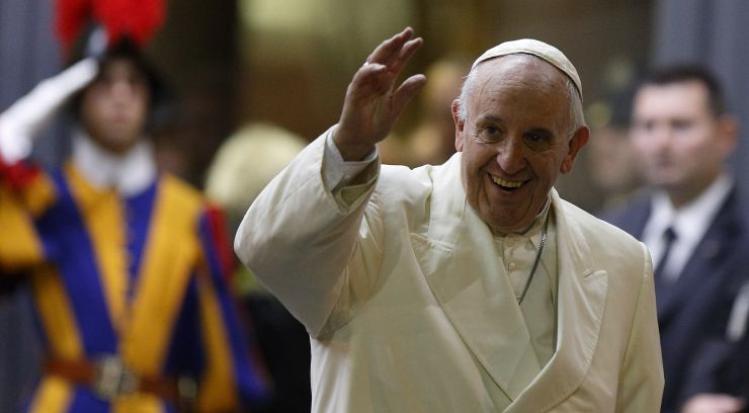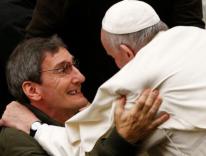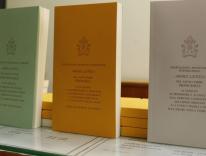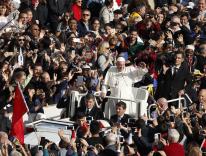
Shortly before the second assembly of the synod began in Rome last October, I was sitting at a table in the Borgo Pio, under the walls of the Vatican, drinking coffee with friends. We had much to talk about, while the evening drew on. Suddenly Cardinal Walter Kasper walked by. He looked concerned: frowning, hunched, talking to himself. I saw in a flash the strain on him, as Pope Francis’s favorite theologian, who had been commissioned to address the cardinals back in February 2014 on how a way of mercy could be opened up to divorced and remarried Catholics, as the other side of God’s judgment, allowing them after a penitential path to take Communion.
In photographs at the end of the synod, however, Kasper looked serene again, smiling. He had been a member of the German-language small discussion group, containing other theological heavyweights such as Cardinal Reinhard Marx, Archbishop of Munich, Cardinal Gerhard Müller, head of the Congregation for the Doctrine of the Faith, and Heiner Koch, the new archbishop of Berlin, moderated with full-on Viennese tact and diplomacy by Cardinal Christoph Schönborn. Observers had thought it impossible for the group to reach an agreed conclusion, seeing that Kasper and Müller had been diametrically opposed. Yet they did. The synod “opened a door,” said Kasper, “though we did not stride through.”
There had been tense battles in this synodal assembly and in its predecessor in 2014. Pope Francis had radically revised the procedures to encourage open debate, and had instigated two unprecedented consultations of the whole church across the spectrum of sexuality and family life. In reaction some cardinals had written books expounding why there could be no change to established pastoral practice. At the start of the second synod thirteen of them had sent Francis a letter complaining that the synod procedures were being manipulated, drawing a sharp papal rebuff. Midway through the first synod the bishops rejected an attempt by Archbishop Bruno Forte and others to amend church language on gays and lesbians in a more positive direction, acknowledging their gifts and talents. The final report of the 2015 synod, more cautious than its 2014 predecessor, did not move an inch from the earlier positions on this.
Yet through the synod process (“journeying together,” as Pope Francis puts it), the bishops had grown. “A synod has a particular grace,” Jean-Paul Vesco, bishop of Oran in Algeria, told a BBC World Service interviewer. Conspicuous in the synod hall because he always wore his white Dominican robes, he testified: “As pastors, we find ourselves renewed. When we said goodbye, we were all smiling. I am going back to my diocese a changed man. I can’t explain it.”
Part of the reason for the change was that Pope Francis, who was present with the bishops throughout, made two stunning keynote speeches. The first was delivered on October 17 to mark the fiftieth anniversary of the institution of the synod by Pope Paul VI during the last session of Vatican II. The “synod” was “one of the most precious legacies” of the council, Francis told his audience. Along the “synodal path” the whole Church—“laity, pastors, the bishop of Rome” (note the order)—could journey together.
So at last the key structural revolution voted by the bishops of Vatican II is having flesh put on its bones. Back then, they had set out on the page their vision of collegiality—a church governed by the episcopal college, with and under the pope, on the pattern of Peter and the Apostles—to replace the absolute monarchy that had been in force. But they gave their doctrine no institutional expression. Within less than three years, Paul VI promulgated his encyclical Humanae vitae reiterating the ban on contraception without a shred of collegial input. Subsequently the synod—which most Vatican II bishops had hoped would continue the council in miniature—became increasingly a rubber stamp on predetermined agendas.
These synods have been different. Indeed, Francis stressed in his speech, the college of bishops is subject to the pope as their head. But though the pope leads the church, he is within it, not by himself above it. In the church, “as in an inverted pyramid, the top is beneath the base.” Francis sees “an urgent need to think about a conversion of the papacy.”
He wants to promote “a sound decentralization.” This would include “in a special way” a recognition of bishops’ conferences as “intermediate instances of collegiality”—previously denied. Bishops are not altar boys.
“Peter’s successor was among us,” says Bishop Vesco. “He wants something from his church, and he’s determined, but he knows he can’t do it alone. He wants to move forwards with us. The synod went as far as it could. The path of reconciliation is open and signposted. Now we have to wait for a word from the Pope”—which will come in his apostolic exhortation.
The synodal bishops have left him plenty of handles to use. Their reports are not legislative or teaching texts. They are reflections.
Francis is likely to be bold, judging by his second great speech, delivered on October 24 to mark the conclusion of the synod’s work. Summing up, he said the synodal assemblies had exhibited “the vitality of the Catholic Church, which is not afraid to stir dull consciences or to soil her hands with lively and frank discussion.” The Gospel “continues to be a vital source of eternal newness, against all who would ‘indoctrinate’ it in dead stones to be hurled at others.” The synods had tried “to open up broader horizons, rising above conspiracy theories and blinkered viewpoints.”
Then came his personal creed. “The synod experience made us better realize that the true defenders of doctrine are not those who uphold its letter, but its spirit.”
A few will have hated it. For many others, however, it will have come over as raw evangelism. The words hit me between the eyes. I got up from my desk and walked around the room. I felt excited and challenged.
I think back often to that first public appearance of Francis as pope after his election, on the balcony of St. Peter’s. His first words contained unmistakable pointers to a new beginning. He described himself as bishop of Rome, not as pope. He had been called “almost from the ends of the earth,” he said, to take the chair of Peter in the see “which presides in charity over all the Churches”—charity, not monarchical authority.
So this, I realized as I watched on television, was still a church of surprises. Vatican II lived on in it. A weight accumulated over thirty-five years dropped from my shoulders.
I have three goddaughters. All have what I would call a religious attitude on life, though none has any allegiance to any Christian denomination. I was having an extended brunch with one of them recently at a local café. “He is showing us again,” she said, “what the Christian faith is really about.”
This has remained Francis’s trump card, that the people are with him. He is wildly popular. In a couple of years he has turned public opinion of Catholicism outside the church right round in the opposite direction. The bishops know that.
Faced with such change, however, some cardinals see “confusion.” Some even say that the ship of the church is adrift without a rudder—ignoring that there is a master strategist at the helm. An apocryphal story is going the rounds. Francis meets a group of pilgrims who offer him some of the tea he loves, maté. He drinks it down. Afterwards his retinue remonstrate with him. It might have been poisoned, they say. “Really?” Francis asks. “They were pilgrims, not cardinals.”
He reaches out undeterred. All this is work in progress. Some of it has hardly started. How is it possible, for example, to hold a synod on the family where the women observers do not even have a vote? How many of the bishops gathered to advise the pope on family life, asks Mary McAleese, former president of Ireland, have ever changed a baby’s nappy?
But no one thinks this is the end. It is the end of the beginning. “We have come part of the way,” Francis told the synod participants in his October 17 speech.
In his latest book, Francis of Rome and Francis of Assisi, the Brazilian liberation theologian Leonardo Boff, who has come in from the cold under this papacy, has compared the Poverello and the pope who has dared to take his name. St. Francis’s program was “too utopian,” Boff, himself a former Franciscan, admits. Perhaps, he muses, it was necessary to wait for a Jesuit, schooled in the Society’s discipline and equipped with its characteristic discernment, to make the dream a reality.
It is a high-wire act. But hope is now the name of the game.
Please email comments to [email protected] and join the conversation on our Facebook page.
Previous Story
The Real Problem with 'Faithful Citizenship'
Next Story
After Paris


